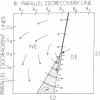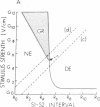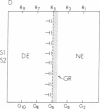Abstract
The hypothesis was tested that the field of a premature (S2) stimulus, interacting with relatively refractory tissue, can create unidirectional block and reentry in the absence of nonuniform dispersion of recovery. Simultaneous recordings from a small region of normal right ventricular (RV) myocardium were made from 117 to 120 transmural or epicardial electrodes in 14 dogs. S1 pacing from a row of electrodes on one side of the mapped area generated parallel activation isochrones followed by uniform parallel isorecovery lines. Cathodal S2 shocks of 25 to 250 V lasting 3 ms were delivered from a mesh electrode along one side of the mapped area to scan the recovery period, creating isogradient electric field lines perpendicular to the isorecovery lines. Circus reentry was created following S2 stimulation; initial conduction was distant from the S2 site and spread towards more refractory tissue. Reentry was clockwise for right S1 (near the septum) with top S2 (near the pulmonary valve) and for left S1 with bottom S2; and counterclockwise for right S1 with bottom S2 and left S1 with top S2. The center of the reentrant circuit for all S2 voltages and coupling intervals occurred at potential gradients of 5.1 +/- 0.6 V/cm (mean +/- standard deviation) and at preshock intervals 1 +/- 3 ms longer than refractory periods determined locally for a 2 mA stimulus. Thus, when S2 field strengths and tissue refractoriness are uniformally dispersed at an angle to each other, circus reentry occurs around a "critical point" where an S2 field of approximately 5 V/cm intersects tissue approximately at the end of its refractory period.
Full text
PDF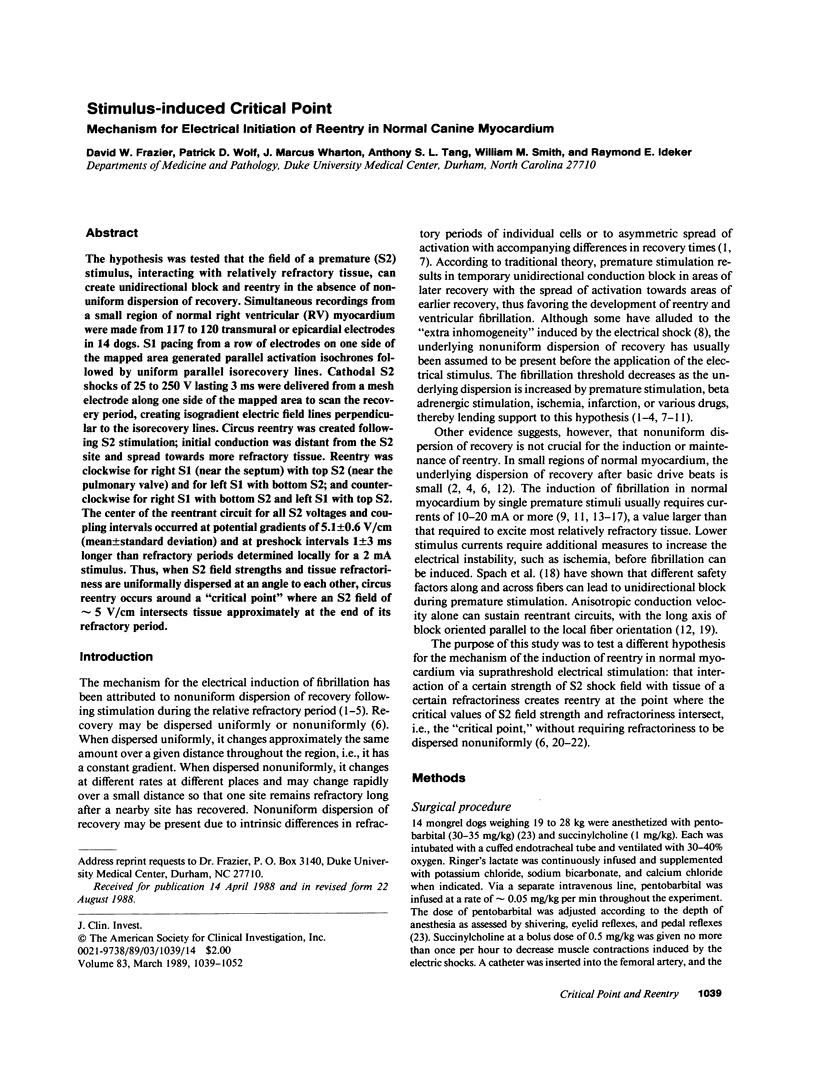
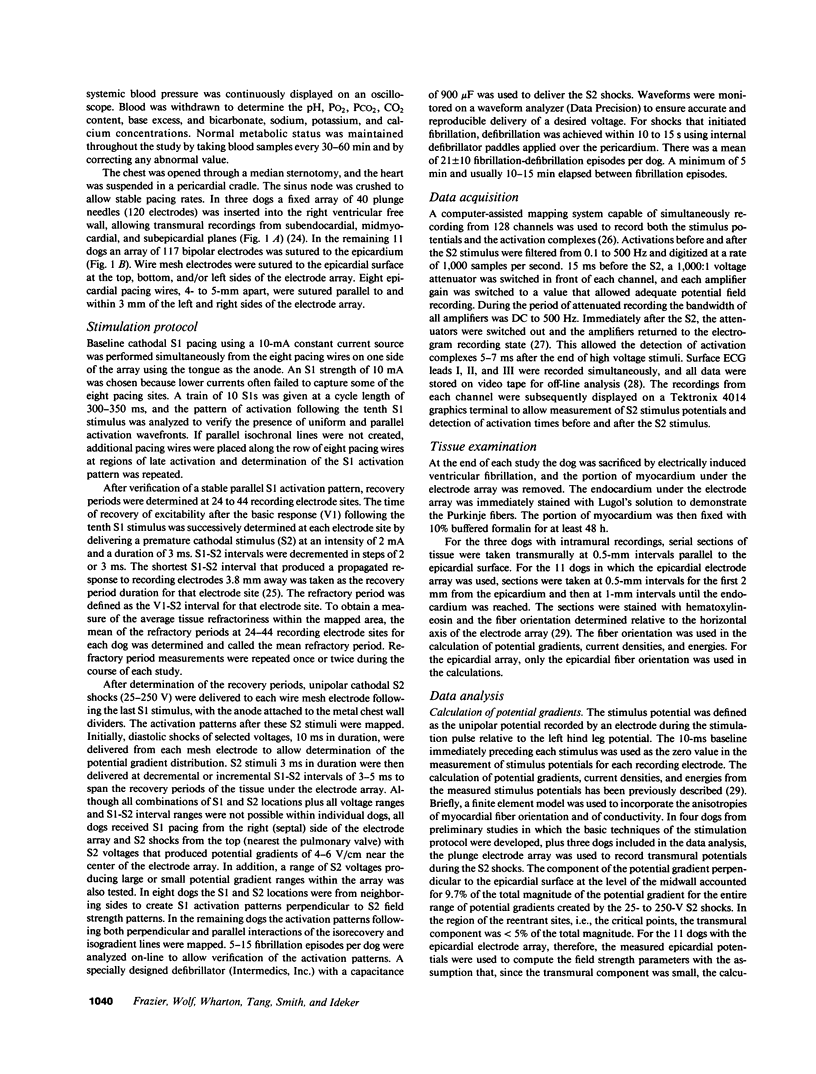
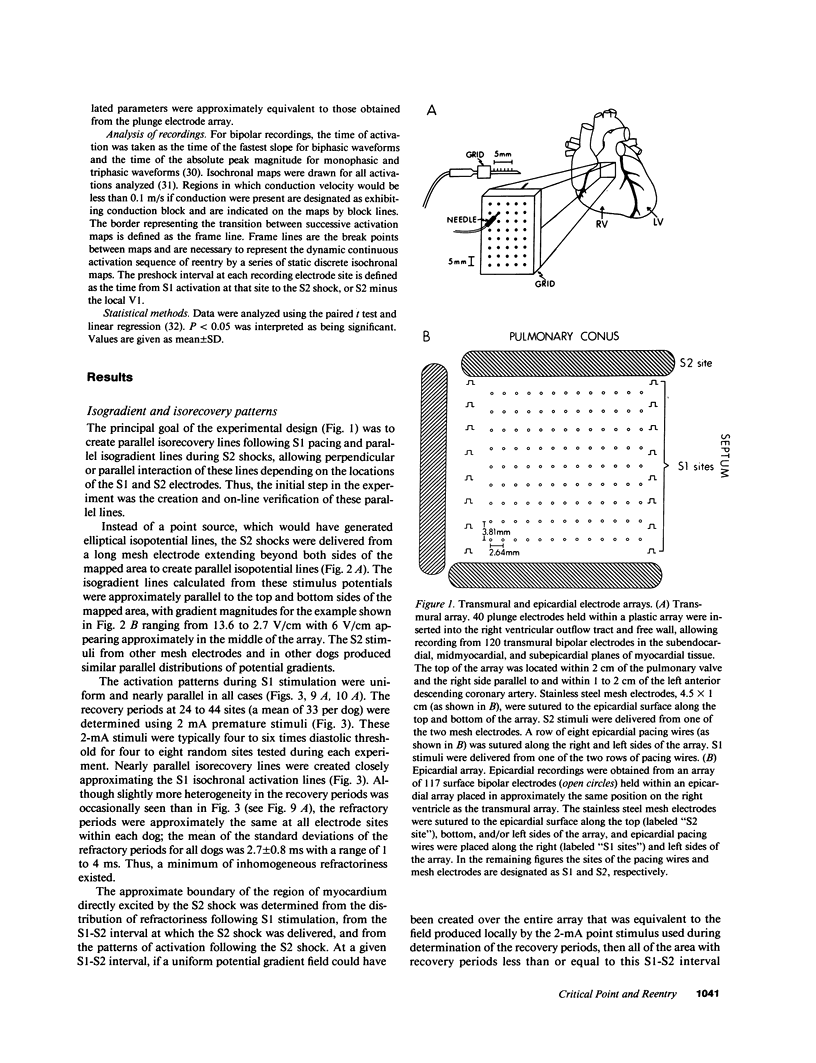
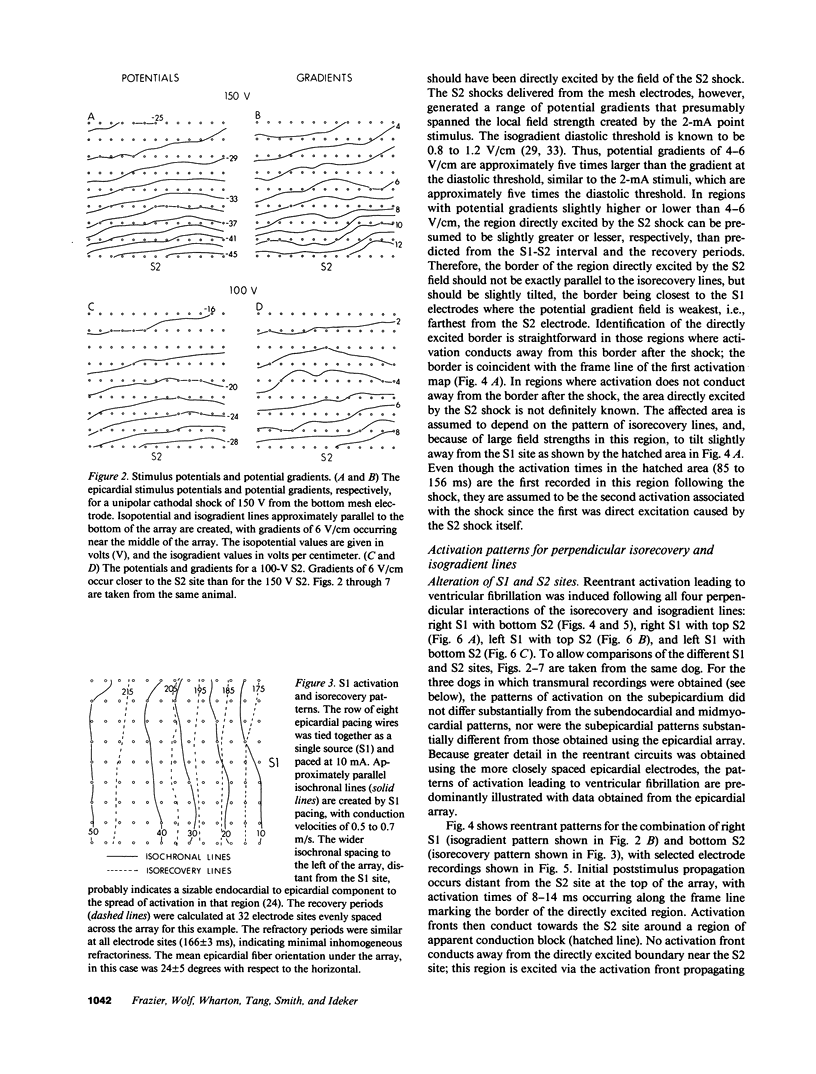
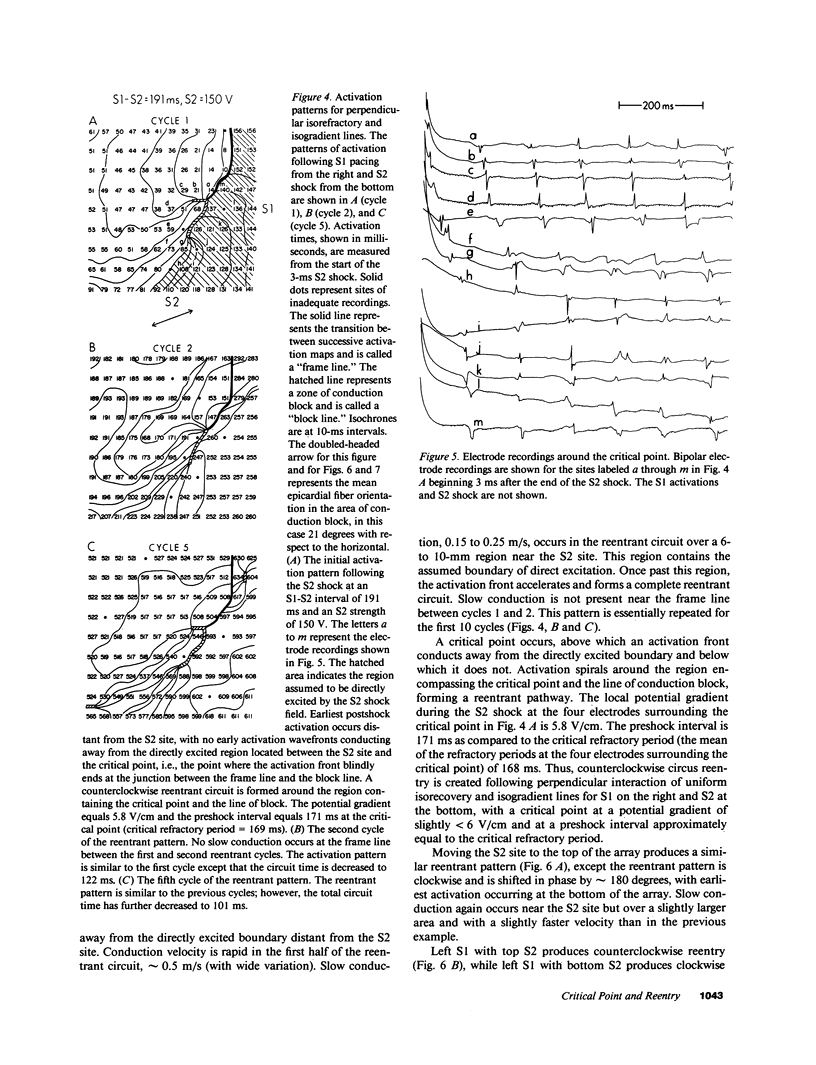
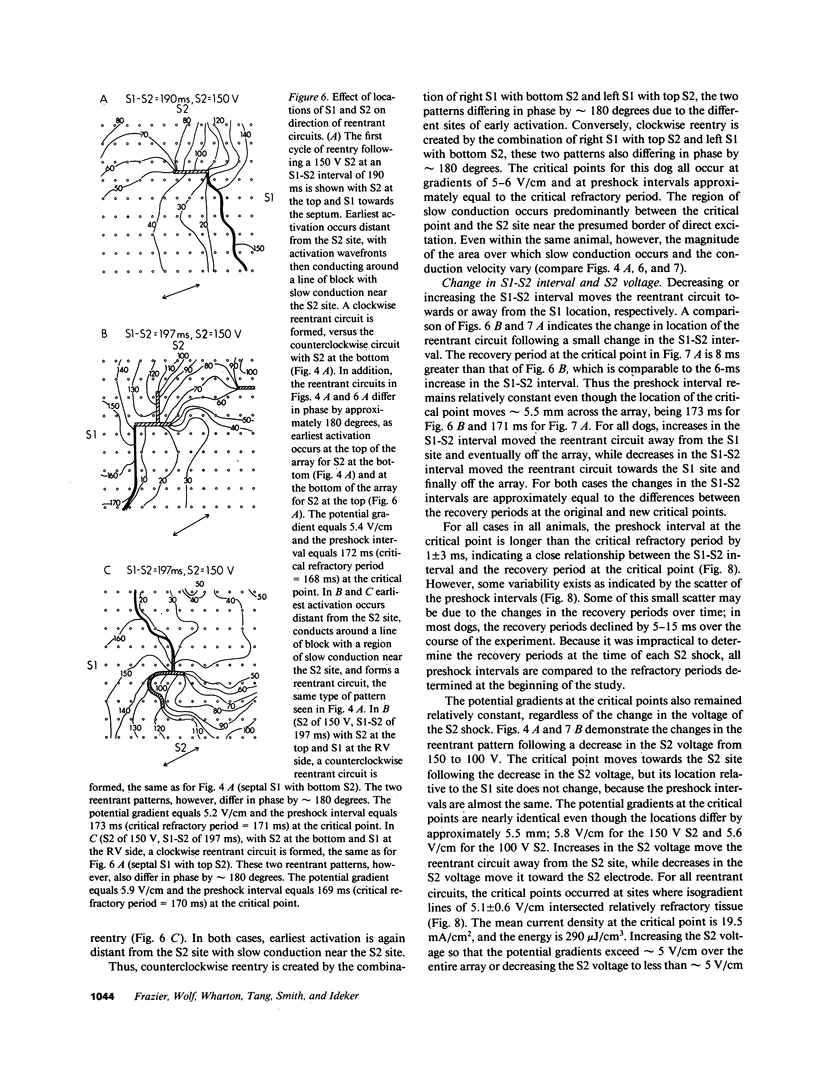
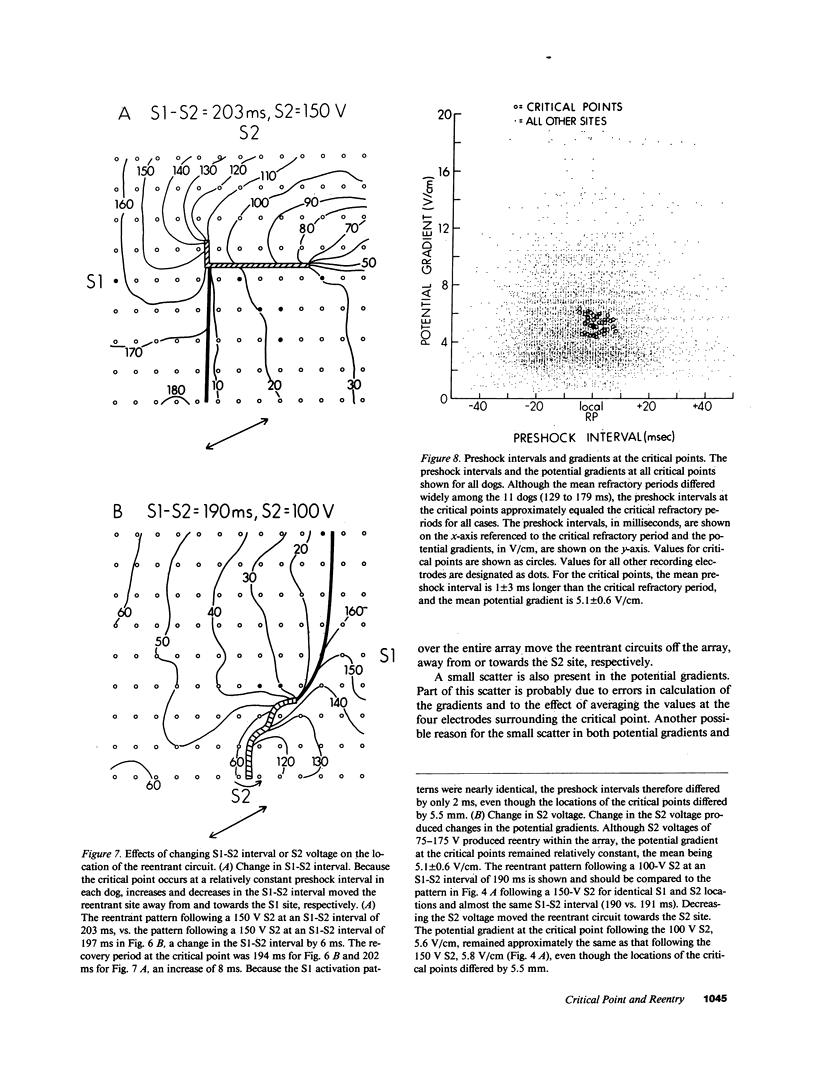
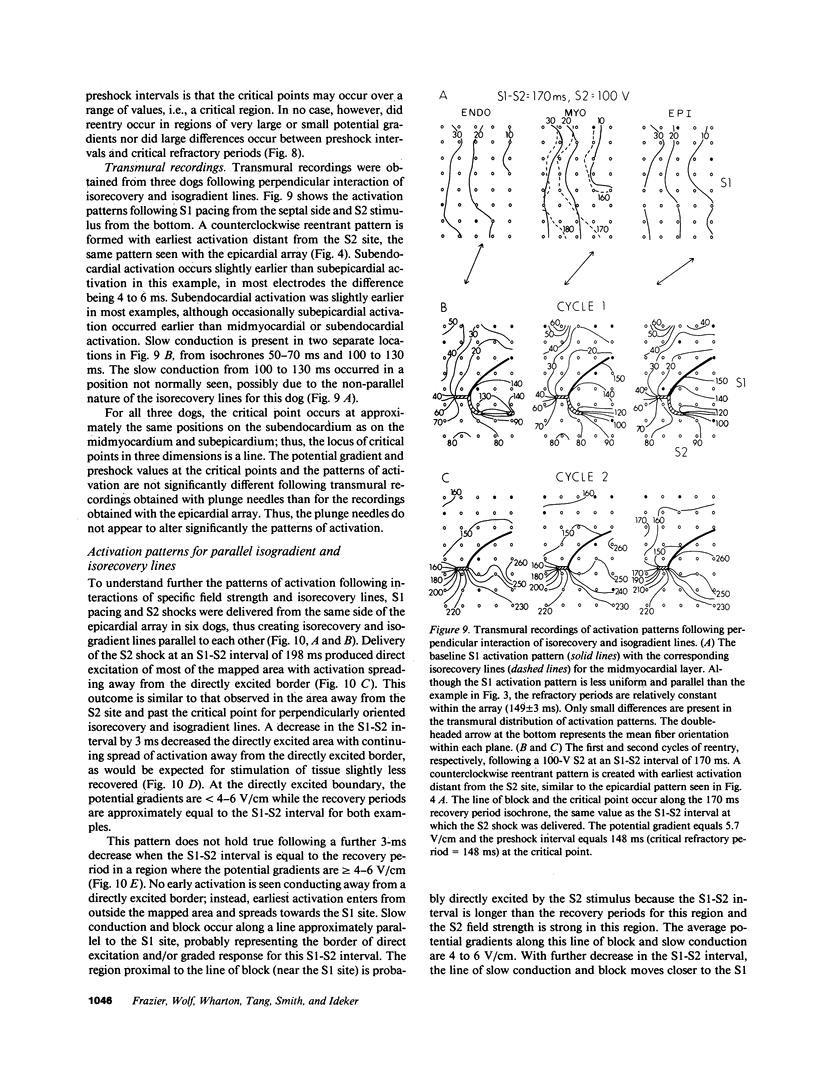
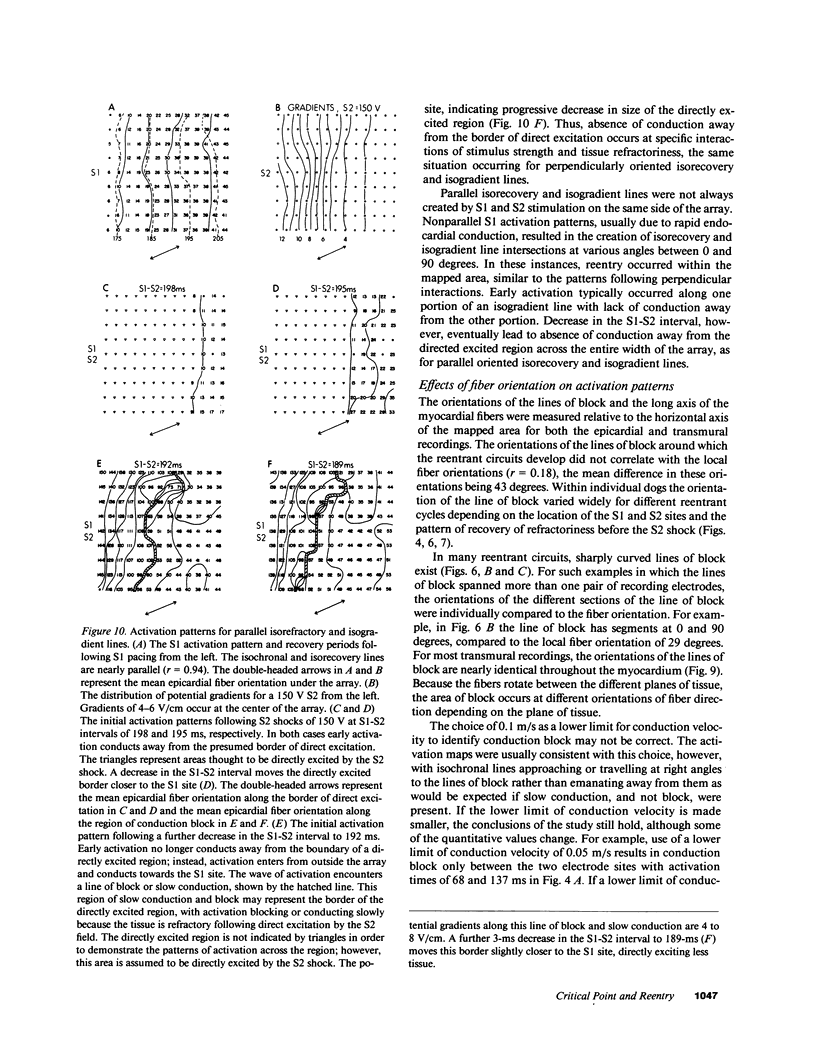
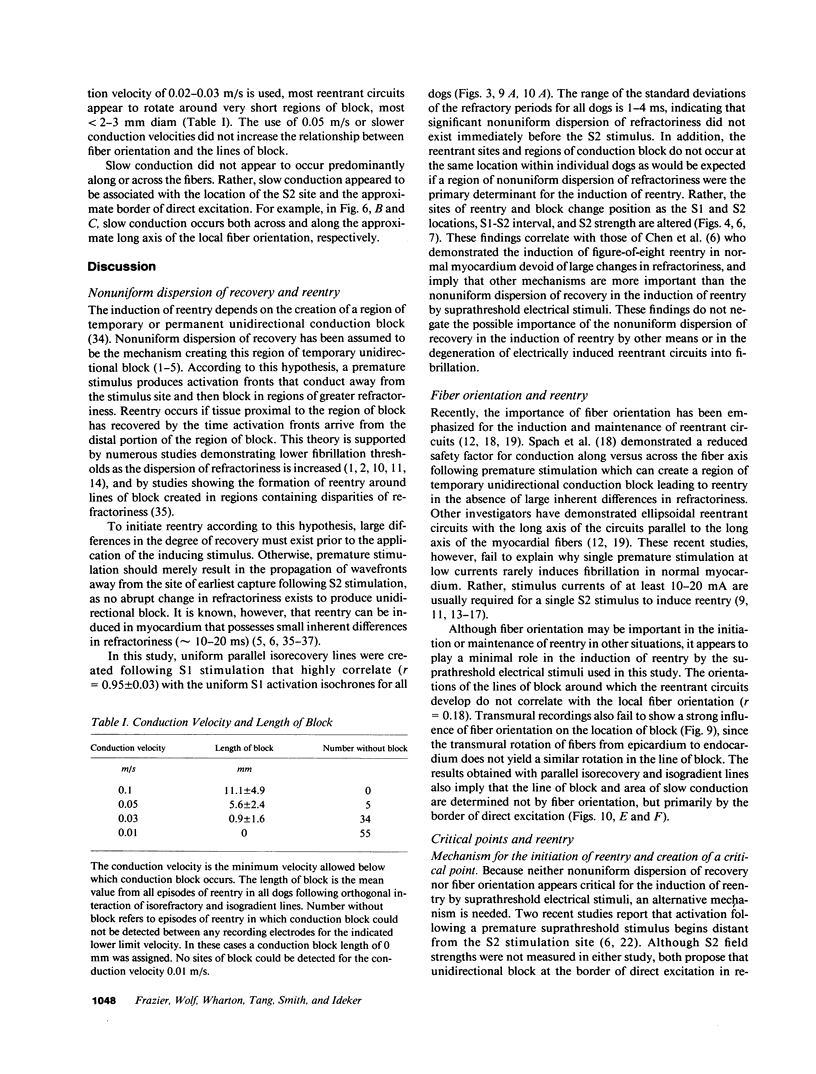
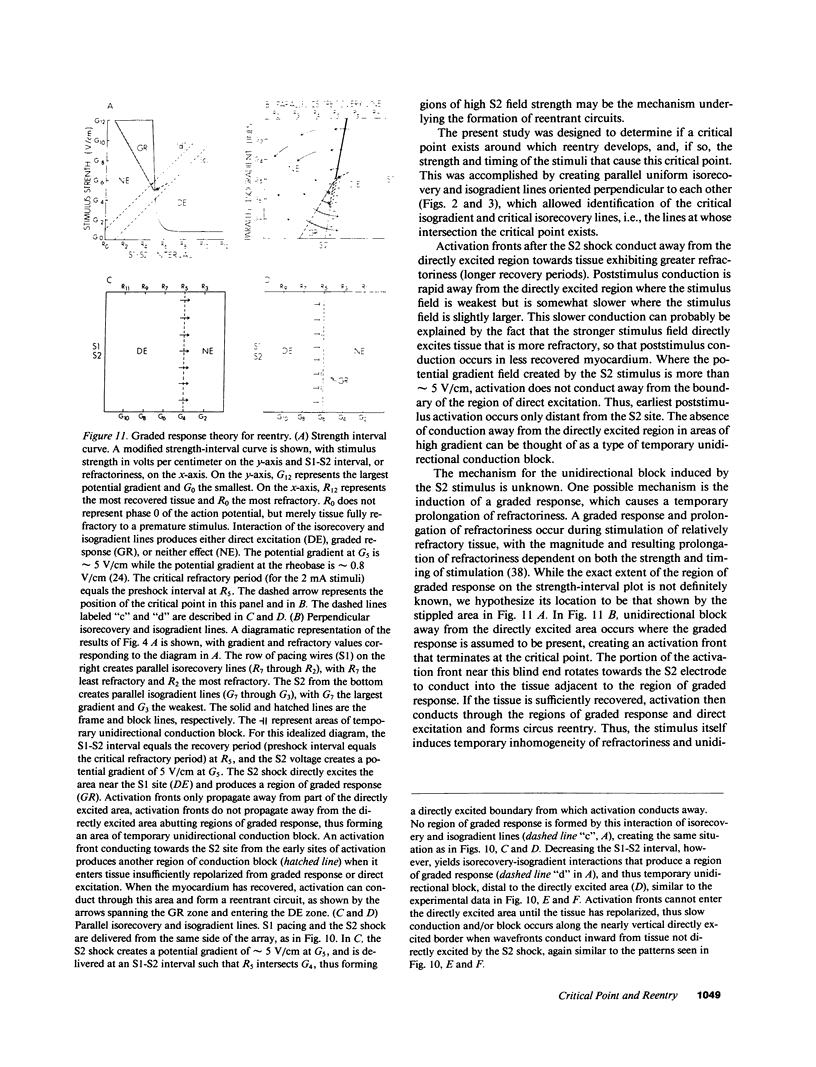
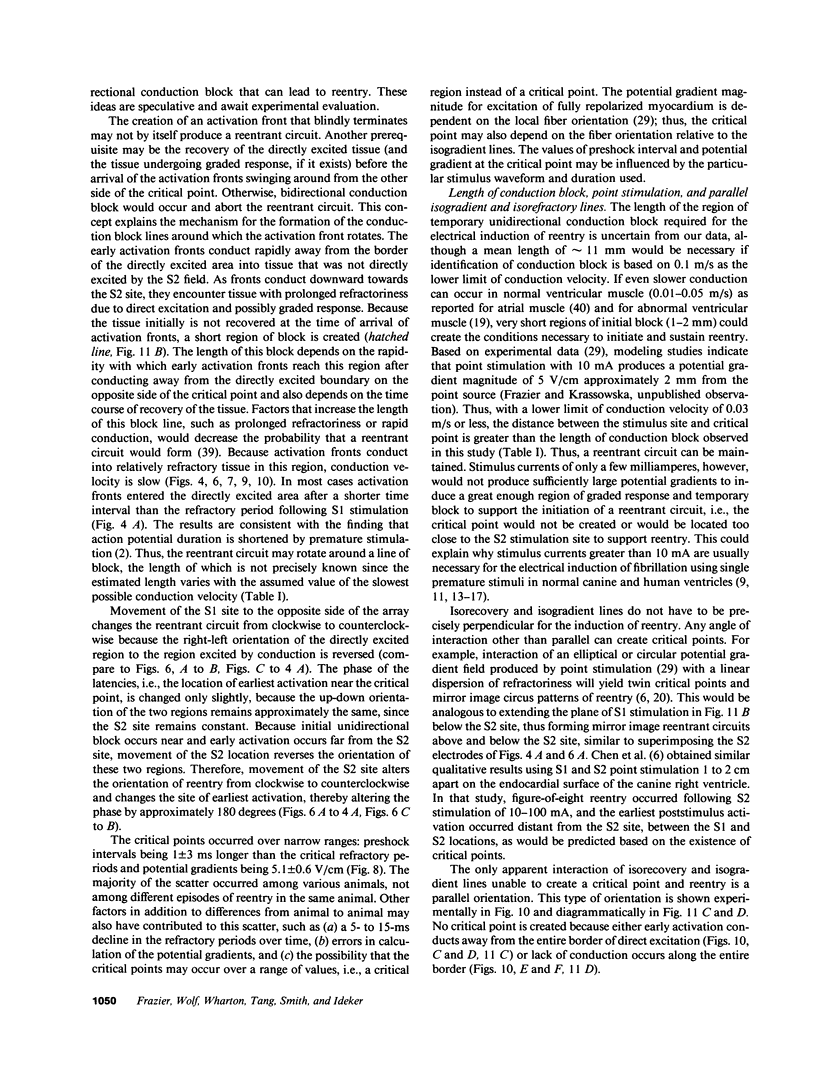
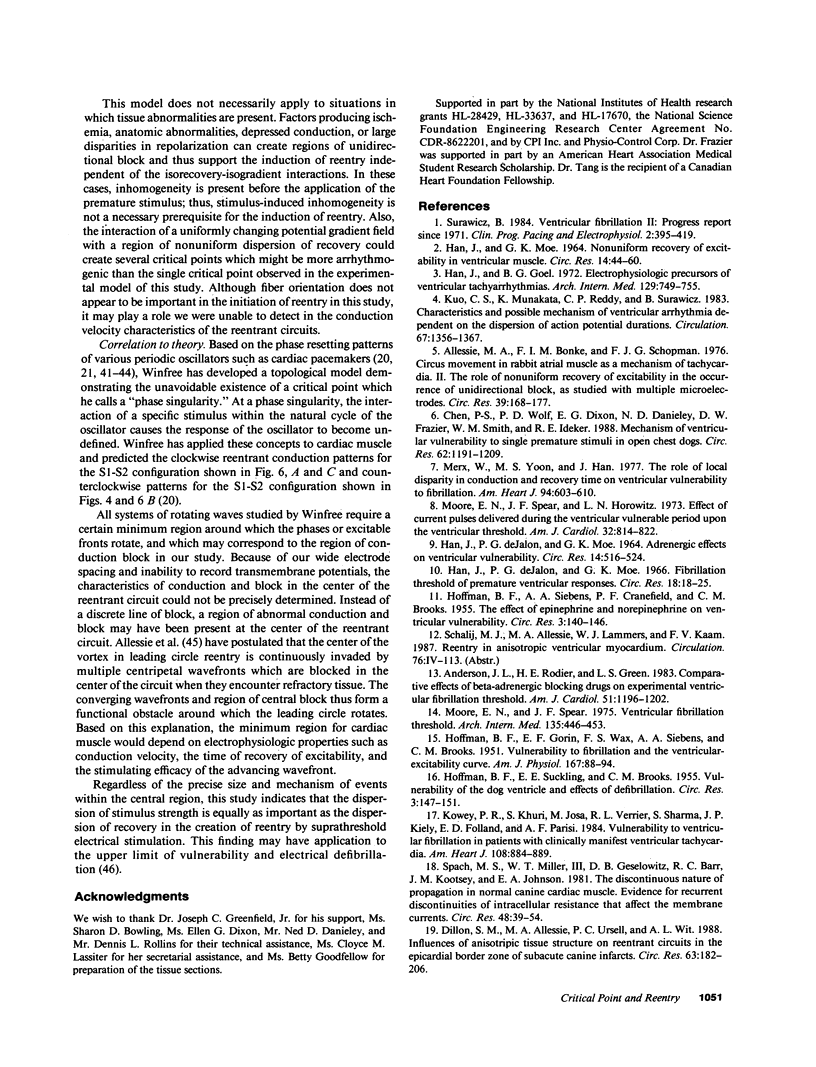
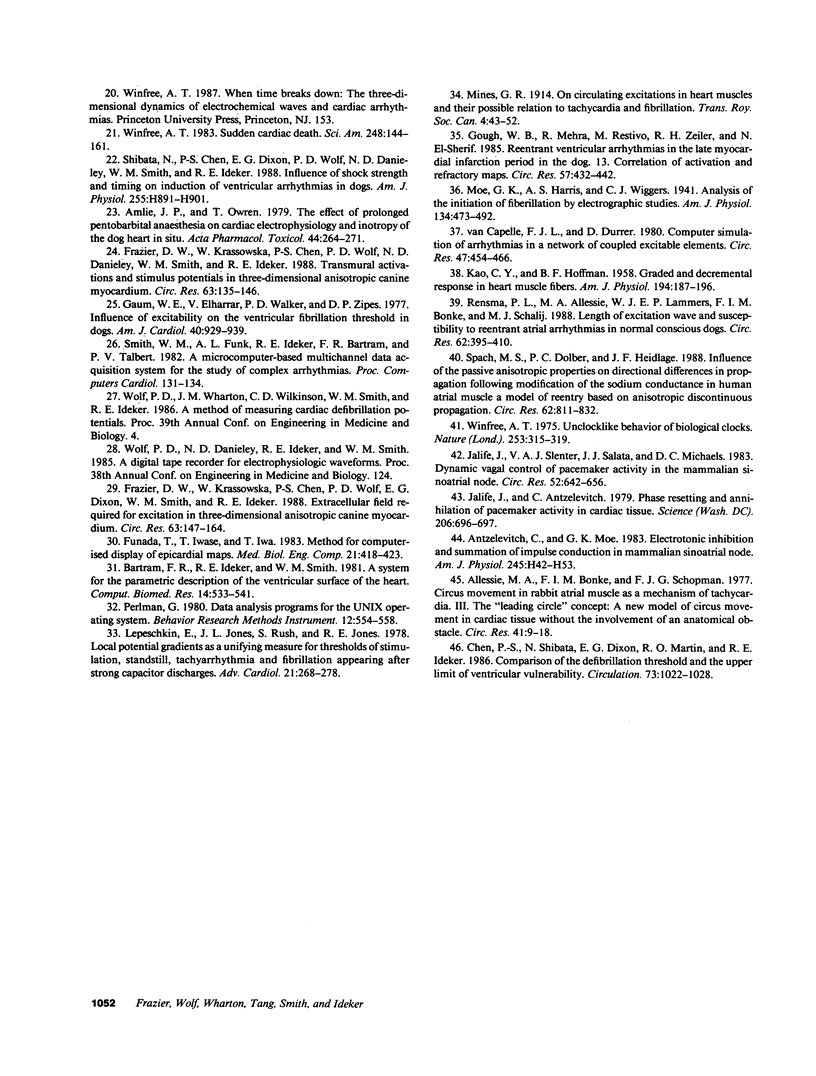
Images in this article
Selected References
These references are in PubMed. This may not be the complete list of references from this article.
- Allessie M. A., Bonke F. I., Schopman F. J. Circus movement in rabbit atrial muscle as a mechanism of tachycardia. II. The role of nonuniform recovery of excitability in the occurrence of unidirectional block, as studied with multiple microelectrodes. Circ Res. 1976 Aug;39(2):168–177. doi: 10.1161/01.res.39.2.168. [DOI] [PubMed] [Google Scholar]
- Allessie M. A., Bonke F. I., Schopman F. J. Circus movement in rabbit atrial muscle as a mechanism of tachycardia. III. The "leading circle" concept: a new model of circus movement in cardiac tissue without the involvement of an anatomical obstacle. Circ Res. 1977 Jul;41(1):9–18. doi: 10.1161/01.res.41.1.9. [DOI] [PubMed] [Google Scholar]
- Amlie J. P., Owren T. The effect of prolonged pentobarbital anaesthesia on cardiac electrophysiology and inotropy of the dog heart in situ. Acta Pharmacol Toxicol (Copenh) 1979 Apr;44(4):264–271. doi: 10.1111/j.1600-0773.1979.tb02328.x. [DOI] [PubMed] [Google Scholar]
- Anderson J. L., Rodier H. E., Green L. S. Comparative effects of beta-adrenergic blocking drugs on experimental ventricular fibrillation threshold. Am J Cardiol. 1983 Apr;51(7):1196–1202. doi: 10.1016/0002-9149(83)90368-5. [DOI] [PubMed] [Google Scholar]
- Antzelevitch C., Moe G. K. Electrotonic inhibition and summation of impulse conduction in mammalian Purkinje fibers. Am J Physiol. 1983 Jul;245(1):H42–H53. doi: 10.1152/ajpheart.1983.245.1.H42. [DOI] [PubMed] [Google Scholar]
- Bartram F. R., Ideker R. E., Smith W. M. A system for the parametric description of the ventricular surface of the heart. Comput Biomed Res. 1981 Dec;14(6):533–541. doi: 10.1016/0010-4809(81)90011-2. [DOI] [PubMed] [Google Scholar]
- Chen P. S., Shibata N., Dixon E. G., Martin R. O., Ideker R. E. Comparison of the defibrillation threshold and the upper limit of ventricular vulnerability. Circulation. 1986 May;73(5):1022–1028. doi: 10.1161/01.cir.73.5.1022. [DOI] [PubMed] [Google Scholar]
- Chen P. S., Wolf P. D., Dixon E. G., Danieley N. D., Frazier D. W., Smith W. M., Ideker R. E. Mechanism of ventricular vulnerability to single premature stimuli in open-chest dogs. Circ Res. 1988 Jun;62(6):1191–1209. doi: 10.1161/01.res.62.6.1191. [DOI] [PubMed] [Google Scholar]
- Dillon S. M., Allessie M. A., Ursell P. C., Wit A. L. Influences of anisotropic tissue structure on reentrant circuits in the epicardial border zone of subacute canine infarcts. Circ Res. 1988 Jul;63(1):182–206. doi: 10.1161/01.res.63.1.182. [DOI] [PubMed] [Google Scholar]
- Frazier D. W., Krassowska W., Chen P. S., Wolf P. D., Danieley N. D., Smith W. M., Ideker R. E. Transmural activations and stimulus potentials in three-dimensional anisotropic canine myocardium. Circ Res. 1988 Jul;63(1):135–146. doi: 10.1161/01.res.63.1.135. [DOI] [PubMed] [Google Scholar]
- Frazier D. W., Krassowska W., Chen P. S., Wolf P. D., Dixon E. G., Smith W. M., Ideker R. E. Extracellular field required for excitation in three-dimensional anisotropic canine myocardium. Circ Res. 1988 Jul;63(1):147–164. doi: 10.1161/01.res.63.1.147. [DOI] [PubMed] [Google Scholar]
- Funada T., Iwase T., Iwa T. Method for the computerised display of epicardial maps. Med Biol Eng Comput. 1983 Jul;21(4):418–423. doi: 10.1007/BF02442628. [DOI] [PubMed] [Google Scholar]
- Gaum W. E., Elharrar V., Walker P. D., Zipes D. P. Influence of excitability on the ventricular fibrillation threshold in dogs. Am J Cardiol. 1977 Dec;40(6):929–935. doi: 10.1016/0002-9149(77)90044-3. [DOI] [PubMed] [Google Scholar]
- Gough W. B., Mehra R., Restivo M., Zeiler R. H., el-Sherif N. Reentrant ventricular arrhythmias in the late myocardial infarction period in the dog. 13. Correlation of activation and refractory maps. Circ Res. 1985 Sep;57(3):432–442. doi: 10.1161/01.res.57.3.432. [DOI] [PubMed] [Google Scholar]
- HAN J., GARCIADEJALON P., MOE G. K. ADRENERGIC EFFECTS ON VENTRICULAR VULNERABILITY. Circ Res. 1964 Jun;14:516–524. doi: 10.1161/01.res.14.6.516. [DOI] [PubMed] [Google Scholar]
- HAN J., MOE G. K. NONUNIFORM RECOVERY OF EXCITABILITY IN VENTRICULAR MUSCLE. Circ Res. 1964 Jan;14:44–60. doi: 10.1161/01.res.14.1.44. [DOI] [PubMed] [Google Scholar]
- HOFFMAN B. F., GORIN E. F., WAX F. S., SIEBENS A. A., BROOKS C. M. Vulnerability to fibrillation and the ventricular-excitability curve. Am J Physiol. 1951 Oct;167(1):88–94. doi: 10.1152/ajplegacy.1951.167.1.88. [DOI] [PubMed] [Google Scholar]
- HOFFMAN B. F., SIEBENS A. A., CRANEFIELD P. F., BROOKS C. M. The effect of epinephrine and norepinephrine on ventricular vulnerability. Circ Res. 1955 Mar;3(2):140–146. doi: 10.1161/01.res.3.2.140. [DOI] [PubMed] [Google Scholar]
- HOFFMAN B., SUCKLING E. E., BROOKS C. M. Vulnerability of the dog ventricle and effects of defibrillation. Circ Res. 1955 Mar;3(2):147–151. doi: 10.1161/01.res.3.2.147. [DOI] [PubMed] [Google Scholar]
- Han J., Garcia de Jalon P. D., Moe G. K. Fibrillation threshold of premature ventricular responses. Circ Res. 1966 Jan;18(1):18–25. doi: 10.1161/01.res.18.1.18. [DOI] [PubMed] [Google Scholar]
- Han J., Goel B. G. Electrophysiologic precursors of ventricular tachyarrhythmias. Arch Intern Med. 1972 May;129(5):749–755. [PubMed] [Google Scholar]
- Jalife J., Antzelevitch C. Phase resetting and annihilation of pacemaker activity in cardiac tissue. Science. 1979 Nov 9;206(4419):695–697. doi: 10.1126/science.493975. [DOI] [PubMed] [Google Scholar]
- Jalife J., Slenter V. A., Salata J. J., Michaels D. C. Dynamic vagal control of pacemaker activity in the mammalian sinoatrial node. Circ Res. 1983 Jun;52(6):642–656. doi: 10.1161/01.res.52.6.642. [DOI] [PubMed] [Google Scholar]
- KAO C. Y., HOFFMAN B. F. Graded and decremental response in heart muscle fibers. Am J Physiol. 1958 Jul;194(1):187–196. doi: 10.1152/ajplegacy.1958.194.1.187. [DOI] [PubMed] [Google Scholar]
- Kowey P. R., Khuri S., Josa M., Verrier R. L., Sharma S., Kiely J. P., Folland E. D., Parisi A. F. Vulnerability to ventricular fibrillation in patients with clinically manifest ventricular tachycardia. Am Heart J. 1984 Oct;108(4 Pt 1):884–889. doi: 10.1016/0002-8703(84)90450-2. [DOI] [PubMed] [Google Scholar]
- Kuo C. S., Munakata K., Reddy C. P., Surawicz B. Characteristics and possible mechanism of ventricular arrhythmia dependent on the dispersion of action potential durations. Circulation. 1983 Jun;67(6):1356–1367. doi: 10.1161/01.cir.67.6.1356. [DOI] [PubMed] [Google Scholar]
- Lepeschkin E., Jones J. L., Rush S., Jones R. E. Local potential gradients as a unifying measure for thresholds of stimulation, standstill, tachyarrhythmia and fibrillation appearing after strong capacitor discharges. Adv Cardiol. 1978;21:268–278. doi: 10.1159/000400463. [DOI] [PubMed] [Google Scholar]
- Merx W., Yoon M. S., Han J. The role of local disparity in conduction and recovery time on ventricular vulnerability to fibrillation. Am Heart J. 1977 Nov;94(5):603–610. doi: 10.1016/s0002-8703(77)80130-0. [DOI] [PubMed] [Google Scholar]
- Moore E. N., Spear J. F. Ventricular fibrillation threshold; its physiological and pharmacological importance. Arch Intern Med. 1975 Mar;135(3):446–453. doi: 10.1001/archinte.135.3.446. [DOI] [PubMed] [Google Scholar]
- Rensma P. L., Allessie M. A., Lammers W. J., Bonke F. I., Schalij M. J. Length of excitation wave and susceptibility to reentrant atrial arrhythmias in normal conscious dogs. Circ Res. 1988 Feb;62(2):395–410. doi: 10.1161/01.res.62.2.395. [DOI] [PubMed] [Google Scholar]
- Shibata N., Chen P. S., Dixon E. G., Wolf P. D., Danieley N. D., Smith W. M., Ideker R. E. Influence of shock strength and timing on induction of ventricular arrhythmias in dogs. Am J Physiol. 1988 Oct;255(4 Pt 2):H891–H901. doi: 10.1152/ajpheart.1988.255.4.H891. [DOI] [PubMed] [Google Scholar]
- Spach M. S., Dolber P. C., Heidlage J. F. Influence of the passive anisotropic properties on directional differences in propagation following modification of the sodium conductance in human atrial muscle. A model of reentry based on anisotropic discontinuous propagation. Circ Res. 1988 Apr;62(4):811–832. doi: 10.1161/01.res.62.4.811. [DOI] [PubMed] [Google Scholar]
- Spear J. F., Moore E. N., Horowitz L. N. Effect of current pulses delivered during the ventricular vulnerable period upon the ventricular fibrillation threshold. Am J Cardiol. 1973 Nov;32(6):814–822. doi: 10.1016/s0002-9149(73)80011-6. [DOI] [PubMed] [Google Scholar]
- Winfree A. T. Sudden cardia death: a problem in topology. Sci Am. 1983 May;248(5):144-9, 152-7, 160-1. doi: 10.1038/scientificamerican0583-144. [DOI] [PubMed] [Google Scholar]
- Winfree A. T. Unclocklike behaviour of biological clocks. Nature. 1975 Jan 31;253(5490):315–319. doi: 10.1038/253315a0. [DOI] [PubMed] [Google Scholar]
- van Capelle F. J., Durrer D. Computer simulation of arrhythmias in a network of coupled excitable elements. Circ Res. 1980 Sep;47(3):454–466. doi: 10.1161/01.res.47.3.454. [DOI] [PubMed] [Google Scholar]



